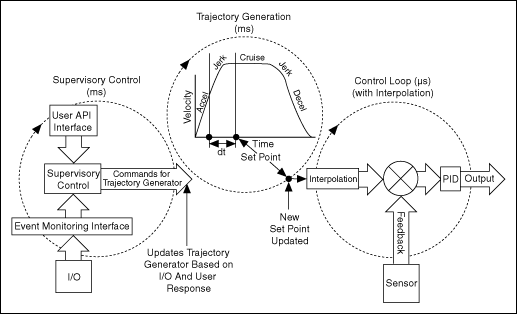NI Motion Controller Functional Components
The following list describes how each component of the 73xx controllers and the NI SoftMotion Controller functions:
- Supervisory control—Performs all the command sequencing and coordination required to carry out the specified operation
- System initialization, which includes homing to a zero position
- Event handling, which includes electronic gearing, triggering outputs based on position, updating profiles based on user defined events, and so on
- Fault Detection, which includes stopping moves on a limit switch encounter, safe system reaction to emergency stop or drive faults, watchdog, and so on
- Trajectory generator—Provides path planning based on the profile specified by the user
- Control loop—Performs fast, closed-loop control with simultaneous position, velocity, and trajectory maintenance on one or more axes
The control loop handles closing the position/velocity loop based on feedback, and it defines the response and stability of the system. For stepper systems, the control loop is replaced with a step generation component. To enable the control loop to execute faster than the trajectory generation, an interpolation component, or spline engine, the control loop interpolates between setpoints calculated by the trajectory generator. The following figure illustrates the functional architecture of NI motion controllers.

- Motion I/O—Analog and digital I/O that sends and receives signals from the rest of the motion control system. Typically, the analog output is used as a command signal for the drive, and the digital I/O is used for quadrature encoder signals as feedback from the motor. The motion I/O performs position breakpoint and high speed capture. Also, the supervisory control uses the motion I/O to achieve certain required functionality, such as reacting to limit switches and creating the movement modes needed to initialize the system.